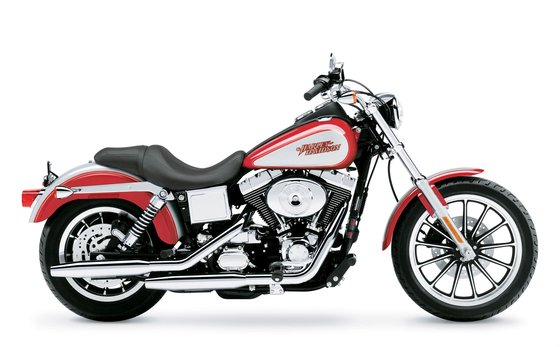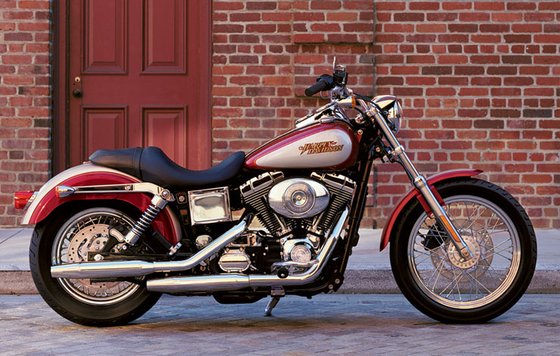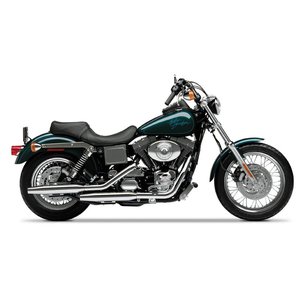Harley-Davidson Dyna Low Rider [1999–2005]: A Timeless Cruiser with Boulevard Swagger

The Harley-Davidson Dyna Low Rider, produced between 1999 and 2005, remains a defining icon of American cruiser motorcycles. With its slammed stance, rumbling Twin Cam 88 engine, and rebellious attitude, this bike isn’t just a machine—it’s a statement. Having spent time with a well-maintained 2003 example, I can confidently say the Dyna Low Rider strikes a rare balance between classic Harley charisma and rideability that appeals to both seasoned riders and newcomers to the brand. Let’s dive into what makes this generation a cult favorite.
Design: Low-Slung Aggression Meets Timeless Style

The Dyna Low Rider’s design ethos screams “boulevard cruiser.” Its 25.2-inch seat height (640 mm) isn’t just a number—it’s a philosophy. Sliding onto the bike feels like lowering into a muscle car, with the low-slung custom seat and mid-mounted foot controls placing you in a relaxed, confidence-inspiring position. The raked-out 32-degree front fork and pull-back handlebars create a stretched, aggressive profile, while the Fat Bob fuel tank (a Harley hallmark) adds muscular visual weight.
Harley offered this generation in bold, era-defining colors like Sierra Red Pearl, Chopper Blue, and Vivid Black, often with two-tone options. The laced wheels (optional in some markets) and chrome accents contrast beautifully with the blacked-out engine components. Details like the tank-mounted speedometer and tachometer, staggered shorty exhausts, and optional highway pegs reinforce its purpose: this is a bike built for cruising in style, not blending into the background.
Engine & Performance: The Heartbeat of the Open Road
At the core of the Dyna Low Rider is the Twin Cam 88 engine (1,449 cc / 88 cu-in), a pushrod-activated, air-cooled V-twin that became synonymous with Harley’s “big twin” identity. With 67–68 HP (50 kW) at 5,200 RPM and a hearty 106–116 Nm (78–86 lb-ft) of torque peaking between 2,900–3,500 RPM, this isn’t a bike about top-speed bragging rights—it’s about that addictive, low-end grunt.
Twisting the throttle unleashes a deep, throaty rumble from the exhausts, and the acceleration feels like being pushed forward by a wave of torque. The power delivery is linear and predictable, making it easy to manage in city traffic while still thrilling on open highways. The 5-speed transmission shifts with a satisfying mechanical clunk, and the belt final drive (a 70/32 ratio) operates seamlessly, requiring minimal maintenance compared to chains.
By 2004, Harley introduced Electronic Sequential Port Fuel Injection (ESPFI) on some models, replacing the 40mm carburetor. While purists might argue for the carb’s analog charm, the EFI models offer smoother cold starts and slightly improved throttle response.
Handling & Ride Quality: Surprisingly Nimble for a Heavyweight
Weighing in at 661 lbs (300 kg) wet, the Dyna Low Rider isn’t light, but its low center of gravity and 64-inch wheelbase (1,625 mm) make it feel surprisingly agile. The 39mm front forks with dual-rate springs and rear coil-over shocks are tuned for comfort, absorbing bumps without wallowing.
In corners, the bike feels planted, with the 150/80-16 rear tire providing ample grip. The steering is heavy at parking speeds but becomes fluid once moving. The dual 292mm front disc brakes (single disc on earlier models) offer decent stopping power, though they require a firm squeeze—a common trait of cruisers of this era.
Comfort: Mile-Eating Ergonomics… With Caveats
The Low Rider’s seat is a mixed bag. The 25.2-inch height is a blessing for shorter riders, but the thinly padded solo seat becomes punishing after an hour. Adding the optional passenger pillion helps, but touring enthusiasts will likely invest in an aftermarket seat.
The mid-mounted controls and pull-back bars create a natural, upright riding position ideal for city rides. However, the lack of wind protection and the forward-mounted highway pegs (on later models) make long highway slogs tiring. This is a bike that thrives on 30–50 mph backroads, where you can savor the engine’s burble and the sun on your back.
Competition: How the Dyna Low Rider Stacks Up
1. Honda Shadow Spirit 1100 (1998–2007)
The Shadow’s liquid-cooled 1,099 cc V-twin is smoother and revvier, producing 61 HP. It’s lighter (584 lbs / 265 kg) and more fuel-efficient but lacks the Harley’s low-end torque and aftermarket customization potential.
2. Yamaha V-Star 1100 Classic (1999–2005)
Yamaha’s cruiser prioritizes comfort with a plush seat and floorboards. Its shaft drive is maintenance-free, but the 63 HP engine feels anemic compared to the Low Rider’s punchy Twin Cam.
3. Indian Chief (1999–2003)
The resurrected Indian Chief rivaled Harley with its 1,638 cc Powerplus engine. It’s more powerful (92 HP) and luxurious but significantly heavier (750 lbs / 340 kg) and rarer in the used market.
Verdict: The Dyna Low Rider outshines competitors with its iconic styling, torque-heavy engine, and vast aftermarket support. It’s less refined than Japanese rivals but offers an irreplaceable “Harley experience.”
Maintenance: Keeping Your Dyna Low Rider Roaring
Owning a Dyna Low Rider isn’t just about riding—it’s about bonding with your machine. Here are key maintenance considerations:
- Oil Changes
-
Use SAE 20W-50 (2.8 liters with filter). Regular changes every 3,000–5,000 km (1,800–3,100 mi) are critical for the air-cooled engine.
-
Primary Chain & Belt Drive
-
Inspect the Zahnriemen (toothed belt) every 10,000 km (6,200 mi) for cracks. Replacement intervals average 50,000 km (31,000 mi).
-
Brake Fluid
-
DOT 5 silicone fluid lasts longer than glycol-based fluids but requires meticulous bleeding to avoid air bubbles.
-
Tire Pressure
-
Maintain 29 PSI (2.0 bar) front and 36 PSI (2.5 bar) rear for optimal grip and wear.
-
Vibration Management
- Check engine mounts and handlebar bolts regularly—the Twin Cam’s vibrations can loosen fasteners over time.
Pro Tip: Upgrade to NGK DCPR7EIX iridium spark plugs for smoother idling and better fuel combustion.
Conclusion: A Legend Worth Preserving
The 1999–2005 Dyna Low Rider isn’t just a motorcycle—it’s a canvas. Whether you’re drawn to its slammed stance, torquey engine, or endless customization potential, this Harley rewards those who embrace its quirks. While modern cruisers offer more technology and comfort, few can match the Low Rider’s raw, mechanical soul.
At MOTOPARTS.store, we’re committed to helping you keep your Dyna Low Rider on the road—and turning heads—with premium aftermarket parts, from performance air filters to retro-style seats. After all, every scratch and modification tells a story. What’s yours?
Specifications sheet
| Engine | |
|---|---|
| Stroke: | Four-stroke |
| Max power: | 50 kW | 67.0 hp |
| Max torque: | 106 Nm |
| Fuel system: | Carburetor (1999-2003) / Electronic Sequential Port Fuel Injection (ESPFI) (2004-2005) |
| Lubrication: | Dry sump with spin-on oil filter |
| Max power @: | 5500 rpm |
| Displacement: | 1449 ccm |
| Max torque @: | 2900 rpm |
| Bore x stroke: | 95.3 x 101.6 mm (3.8 x 4.0 in) |
| Configuration: | V |
| Cooling system: | Air |
| Compression ratio: | 8.9:1 |
| Number of cylinders: | 2 |
| Dimensions | |
|---|---|
| Wheelbase: | 1625 mm (64.0 in) |
| Dry weight: | 300 |
| Seat height: | 640 mm (25.2 in) |
| Overall length: | 2364 mm (93.1 in) |
| Ground clearance: | 142 mm (5.6 in) |
| Fuel tank capacity: | 17.4 L (4.6 US gal) |
| Drivetrain | |
|---|---|
| Final drive: | belt |
| Gear ratios: | 1st 10.110, 2nd 6.958, 3rd 4.953, 4th 3.862, 5th 3.150 |
| Transmission: | 5-speed |
| Maintenance | |
|---|---|
| Engine oil: | SAE 20W-50 |
| Brake fluid: | DOT 5 Silicone |
| Spark plugs: | NGK DCPR7E / NGK DCPR7EIX |
| Spark plug gap: | 0.8 |
| Valve clearance: | Hydraulic self-adjusting lifters (no manual adjustment required) |
| Coolant capacity: | Air-cooled (no coolant) |
| Forks oil capacity: | 0.62 |
| Engine oil capacity: | 2.8 |
| Transmission oil capacity: | 700 ml SAE 80W-90 |
| Engine oil change interval: | Every 5000 km or 2 years |
| Primary drive oil capacity: | 770 ml |
| Recommended tire pressure (rear): | 2.5 bar (36 psi) |
| Recommended tire pressure (front): | 2.0 bar (29 psi) |
| Chassis and Suspension | |
|---|---|
| Rake: | 29° |
| Frame: | Mild steel tubular frame |
| Trail: | 114 mm (4.5 in) |
| Rear tire: | 150/80-16 |
| Front tire: | 100/90-19 |
| Rear brakes: | Single 292 mm disc |
| Front brakes: | Dual 292 mm discs (single disc on some models) |
| Rear suspension: | Coil-over dual shock |
| Front suspension: | 39 mm telescopic fork with dual-rate springs |
| Rear wheel travel: | 84 mm (3.3 in) |
| Front wheel travel: | 155 mm (6.1 in) |



















